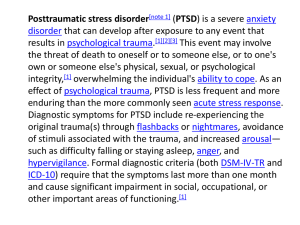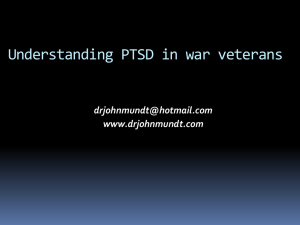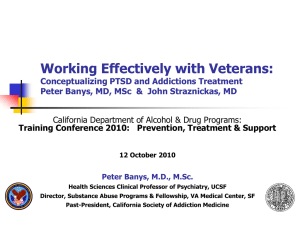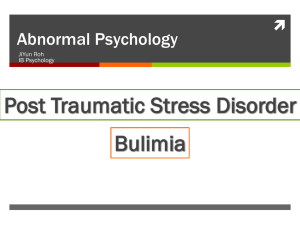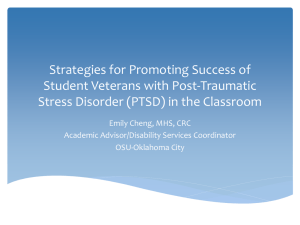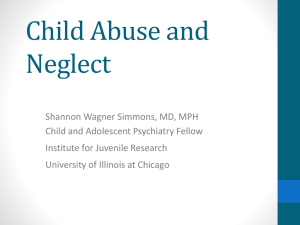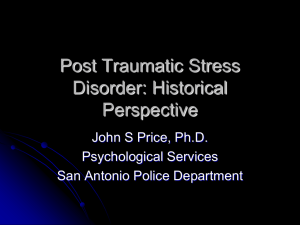2F_Porter_PTSD&TBI_TreatmentOptions_NoGraphics
advertisement
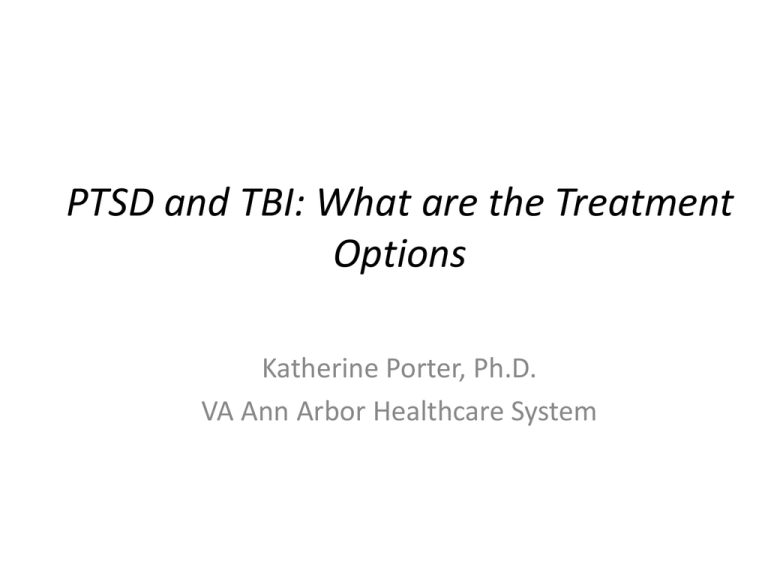
PTSD and TBI: What are the Treatment Options Katherine Porter, Ph.D. VA Ann Arbor Healthcare System • Thank you to collaborators that helped me with this talk (Sheila Rauch, PhD; Erin Smith, PhD, and Melody Powers, LMSW along with others). • Some of the content and slides have been borrowed from previous talks they have given on this topic. Outline • What is PTSD • PTSD and the courts/criminal behavior • Data on TBI and comorbity • Treatment planning with court order patients • Evidence based care for PTSD Response to Trauma and Stress Following trauma many problems may occur and interact Substance Abuse Anxiety Panic Depression PTSD Physical Health Problems Relationship Problems PTSD • Requires: – Event that threatened or caused death, physical injury, threat to physical integrity. – Responded with fear, helplessness, or horror – Recently, this criteria has been removed, but is seen in most cases even if they don’t use the words. • Symptoms: – – – – Reexperiencing of a specific event/s Avoidance Negative alterations in thoughts and mood Alterations in arousal and reactivity • Must impair function for at least one month Normal Reaction vs. Pathology • Most individuals exposed to traumatic situations, do not develop PTSD. • The manifestation of some symptoms during the first 30-90 days after a traumatic experience is not uncommon and is generally part of the normal stress response. • However, a pattern of symptoms that begin to interfere with work, home life or interpersonal relationships marks PTSD. • Persistent symptoms that either do not improve or worsen, even if considered normal initially, become problematic when they do not remit over time. Criminal Behavior and PTSD • Symptoms of PTSD and comorbid disorders may increase chance that a person may experience some legal problems. • • • • • Anger and irritability Hyperarousal/ perception of threat and danger Startle Feelings of disconnection/ isolation and lack of support Intrusions, including flashbacks • Majority of patients with PTSD do not have problems with the law and are not violent. Criminal Behavior and PTSD • Data suggests that PTSD may be linked to violence and aggression (e.g., Kulka et al.,1988; Lasko et al., 1994; Orcutt et al., 2003). – Substance use can increase risk • Presence of PTSD does not suggest criminality and criminal behavior does not mean that symptoms are the cause of the behavior. Anger & PTSD • Elevated levels of anger often seen in trauma survivors and has been shown to be related to severity of PTSD (e.g., Riggs et al., 1992). • Anger is central feature in survival response • Relationship between anger and PTSD stronger in military samples, but not specific to it (e.g., Orth & Wieland, 2006) • Anger levels decrease with treatment of PTSD even if it is not directly targeted (Cahill et al., 2003; Stapleton et al., 2006) Substance Use Disorders and PTSD • Why the link between PTSD and substance use? – High Risk Hypothesis – Susceptibility Hypothesis – Self-medication Hypothesis (most support) • Often conceptualized as avoidance in trauma focused therapy • Data on prevalence varies, but it is estimated that: – 20% seeking help for PTSD have a substance use disorder http://www.ptsd.va.gov/public/pages/ptsd_substance_abuse_veterans.asp – ~33% of veterans seeking help for SUD have PTSD. http://www.ptsd.va.gov/public/pages/ptsd_substance_abuse_veterans.asp – 30–59% of women with SUD have PTSD (Najavits,Weiss, & Shaw, 1997) Traumatic Brain Injury (TBI) • ~1.7 million people sustain a TBI annually – Vast majority don’t require hospitalization CDC (2010). Traumatic Brain Injury in the United States: Emergency Department Visits, Hospitalizations, and Deaths. • Symptoms and course can vary significantly – Can include irritability, changes in mood, behavioral changes • Many symptoms overlap with PTSD Rates of mTBI and PTSD among OIF/OEF Veterans Reported rates of both PTSD and mTBI vary according to the study and may be underreported TBI rates estimated at approaching 20% (Sayer et al., 2009) The majority of these cases are in the mild range of severity Evidence indicates that the majority of these cases resolve within weeks or months PTSD and TBI • Studies looking at rates of PTSD following TBI vary considerably – Depending on methods for diagnosing PTSD rates reported between ~3-30% with interview and ~1859% with self-report (Gill et al., 2014). • PTSD maybe less likely in cases with longer periods of unconsciousness (Glaesser et al., 2004). Assessment and Treatment with Court Ordered Patients • Important to consider history of symptoms and behaviors – Helps to reduce impact of secondary gain – Provides information about potential function of behaviors • Treatment plans should be symptom/diagnosis based • Trauma focused therapies can be effective, but are only therapeutic when patients are willing – Education and rationale are provided to patient and they be strongly encouraged, but not forced. Assessment and Treatment with Court Ordered Patients • PTSD therapies are short-term and involve work outside of the therapy office – Goal is to help person reconnect and engage in their life – Important that they practice skills in their environment • Consistent messages from team (treatment team and courts) is important to help combat avoidance PTSD Treatment Clinical practice guidelines Prolonged Exposure and Cognitive Processing Therapy have been supported as first line treatments for PTSD VA/DOD PTSD Treatment guideline (VA/DOD, 2004, 2010) National Institute of Clinical Excellence (NICE, 2005) International Society of Traumatic Stress Studies (ISTSS, 2009) Institute of Medicine (IOM, 2007) Selective Serotonin Reuptake Inhibitors(SSRIs) are also supported first-line treatment- Zoloft and Paxil Prolonged Exposure (PE) Treatment Procedures • Psychoeducation: Education about treatment and common reactions to trauma; breathing training • Repeated in vivo exposure • Imaginal exposure • Processing of the revisiting and in vivo exposure experiences PE Rationale • Exposure: – Challenges belief that anxiety lasts forever – Challenges belief that memories, people, places, and situations are dangerous – Results in reduction of anxiety without engaging in habitual avoidance behaviors – Helps process traumatic experience(s) – Enhances sense of control Cognitive Processing Therapy (CPT) • • • • Psychoeducation Impact Statement Trauma Account Cognitive Challenge – Identify stuck points – Safety, trust, power/control, esteem, intimacy CPT Rationale o Trauma events change one’s perceptions about the world, themselves, and other people o “The world is dangerous” o “It’s all my fault” o Trauma victims with PTSD have a distorted sense of: o Safety, Trust, Intimacy, Power/Control, Self-Esteem o These distortions keep people stuck in their PTSD symptoms and therefore must be modified to accurately fit the context/reality of situations Initial Data on Outcomes with PTSD/TBI • Sripada et al., 2013 – Examined clinical sample from a VA clinic of PTSD patient who received PE and data from a pilot study – Compared outcomes of participants with and w/out a history of mTBI – Showed that PE was effective in reducing PTSD symptoms and mTBI status did not impact efficacy. The Good News: • PTSD can be a chronic disorder, but with the right treatment patients can get significantly better, including no longer meeting criteria for the disorder post-treatment. • For example, Rauch et al. (2009) found that 80 % of veterans treated with Prolonged Exposure (PE) therapy achieved clinically significant reductions in their PTSD symptoms and 50 % no longer met criteria for PTSD. • Data from VA roll out training of PE demonstrated that the percentage of veterans screening positive dropped from 87.6%to 46.2% (Eftekhari et al., 2013). The Good News: • Monson et al. (2006) found that 40 % of a veteran sample receiving Cognitive Processing Therapy (CPT) did not meet criteria for PTSD compared to 3 % for a wait-list control group. • 50 % of the veterans receiving CPT had a significant reduction in their symptoms, compared to 10 % of the wait-list control group. References • • • • • • • • Cahill, S. P., Rauch, S. A.,Hembree, E. A.,&Foa, E. B. (2003). Effect of cognitive behavioral treatments for PTSD on anger. Journal of Cognitive Psychotherapy, 17, 113–131. CDC (2010). Traumatic Brain Injury in the United States: Emergency Department Visits, Hospitalizations, and Deaths. Retrieved from: http://www.cdc.gov/traumaticbraininjury/pdf/blue_book.pdf Eftekhari, A., Ruzek, J. I., Crowley, J. J., Rosen, C. S., Greenbaum, M. A., & Karlin, B. E. (2013). Effectiveness of national implementation of prolonged exposure therapy in Veterans Affairs care. JAMA psychiatry, 70, 949-955. Glaesser, J., Neuner, F., Lütgehetmann, R., Schmidt, R., & Elbert, T. (2004). Posttraumatic Stress Disorder in patients with traumatic brain injury. BMC psychiatry, 4, 5. Gill, I. J., Mullin, S., & Simpson, J. (2014). Psychosocial and psychological factors associated with post-traumatic stress disorder following traumatic brain injury in adult civilian populations: A systematic review. Brain Injury, 28, 1-14. Kulka, R. et al. (1988). National Vietnam Veterans Readjustment Study: Contractual Report of Findings from the National Vietnam Veterans Readjustment Study, Volumes I&II (Veterans Administration Contract No. V101(93)P‐1040). Research Triangle Park, NC:Research Triangle Institute. Lasko, N.B. et al. (1994). Aggression and its correlates in Vietnam veterans with and without chronic posttraumatic stress disorder. Comprehensive Psychiatry, 35, 373‐381. Monson, C. M., Schnurr, P. P., Resick, P. A., Friedman, M. J., Young-Xu, Y., & Stevens, S. P. (2006). Cognitive processing therapy for veterans with military-related posttraumatic stress disorder. Journal of Consulting and clinical Psychology, 74, 898. References • • • • • • • • Najavits, L.M., Weiss, R.D. & Shaw, S.R. (1997). The link between substance abuse and posttraumatic stress disorder in women: A research review. The American Journal on Addictions, 6, 273-283. Orcutt, HK, et al., (2003). Male‐perpetrated violence among Vietnam veteran couples: Relationships with veteran’s early life characteristics, trauma history, and PTSD symptomatology. Journal of Traumatic Stress, 16, 381 – 390. Orth, U., & Wieland, E. (2006). Anger, hostility, and posttraumatic stress disorder in trauma-exposed adults: A metaanalysis. Journal of Consulting and Clinical Psychology, 74, 698–706. Rauch, S. A. M., Defever, E., Favorite, T., Duroe, A., Garrity, C., Martis, B. and Liberzon, I. (2009), Prolonged exposure for PTSD in a Veterans Health Administration PTSD clinic. Journal of Traumatic Stress, 22: 60–64. Riggs, D. S., Dancu, C. V., Gershuny, B. S., Greenberg, D., & Foa, E. B.(1992). Anger and post-traumatic stress disorder in female crime victims.Journal of Traumatic Stress, 5, 613–625. Sayer, N.A., Rettmann, N.A., Carlson, K. F., Bernardy, N., Sigford, B. J., et al. (2009). Veterans with history of mild traumatic brain injury and posttraumatic stress disorder. Challenges from providers perspective. Journal of Rehabilitation Research & Development, 46, 703-716. Sripada, R. K., Rauch, S. A., Tuerk, P. W., Smith, E., Defever, A. M., Mayer, R. A, et al., (2013). Mild traumatic brain injury and treatment response in prolonged exposure for PTSD. Journal of traumatic stress, 26(3), 369-375. Stapleton JA, Taylor S, Asmundson GJ. (2006). Effects of three PTSD treatments on anger and guilt: exposure therapy, eye movement desensitization and reprocessing, and relaxation training. Journal of Traumatic Stress 19,19-28.



